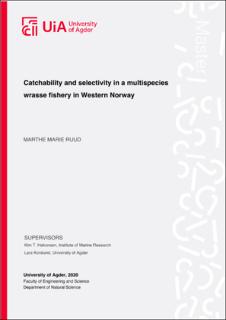Catchability and selectivity in a multispecies wrasse fishery in Western Norway
Master thesis
Permanent lenke
https://hdl.handle.net/11250/2678975Utgivelsesdato
2020Metadata
Vis full innførselSamlinger
Originalversjon
Ruud, M. M. (2020) Catchability and selectivity in a multispecies wrasse fishery in Western Norway (Master's thesis). University of Agder, Kristiansand.Sammendrag
Goldsinny(Ctenolabrus rupestris), corkwing(Symphodus melops)and ballan wrasse(Labrus bergylta) are heavily harvested on the west coast of Norway because of their delousing ability andare supplied to the aquaculture industry as a key tool incontrollingsalmon lice infestations. Despite rapid development of the fishery in the past decade, knowledge on catchabilityand selectivity in this multispecies fisheryis still limited. This information is essential to ensure sustainable harvesting levels and developing good management strategies for wrasse.In a before-after control-impact (BACI) study, passive integrated transmitter (PIT) tags wereused to monitorthe fate of individual wrassesbefore,during and after a period of controlled fishingto quantify species-specific catchability and within-species selectivityin the fishery.Additionally, six indicators were tested for their usefulness in wrasse population monitoring.Logistic regression analysis revealed similar catchability for goldsinny and corkwing (17.5%). Exceptionally low recapture rateof ballan wrasse in the fishery indicates very modest catchability of this species. Thewrassefishery was found to be size-and sex-selective in corkwing.Capture probability was negatively correlated with body sizeindependent of sex andsneaker males entering the fishery (12 cm) had significantly higher catchability (40%) compared with females (25%) and nesting males (17%) of the same size. In goldsinny, the fishery was observed to be sex-selective withsignificantlyhighercatchability of territorial males(18%)relative to females(8%). The impact of fishing was successfully detected with three indicators; the proportion of harvestable individuals, proportion of corkwing to goldsinny and catch per unit effort (CPUE) of harvestable individuals. Length-and sex-based indicators did not show any significant effects caused by the fishery. The findings of this study are relevant for improving regulations of the wrasse fishery. The catchabilities found in this study are highly valuable forfuture stock abundance assessments for the wrasses.Lastly, the observed patterns in selectivitysupportincreasing the minimum size limit for corkwing nesting males to protect immature individuals.
Beskrivelse
Master's thesis in Coastal ecology (BIO501)

